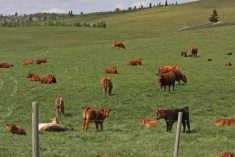EDMONTON – Independent stores, greenhouses or nurseries need to be different from their multinational competitors if they’re going to survive, said a Nova Scotia greengrocer who has thrived in a tough food business.
Pete Luckett, the celebrity English grocer now located in Canada, said independent stores need to be first, best or different from their competitors.
“It’s tough to be first, but best and different is possible,” Luckett told the Green Industry Show and Conference for the greenhouse, nursery and landscape business Nov. 15.
Attracting and encouraging customers to spend money on bedding plants is no different than getting customers to buy unusual vegetables in his Pete’s Frootique grocery stores.
Read Also

Know what costs are involved in keeping crops in the bin
When you’re looking at full bins and rising calf prices, the human reflex is to hold on and hope for more. That’s not a plan. It’s a bet. Storage has a price tag.
“Seventy percent of purchases are solely on impulse. Very few customers arrive with a shopping list,” Luckett told the greenhouse operators.
Colour, lighting, signage and unique food items are all key to attracting customers and encouraging them to buy.
Luckett is constantly looking for new fruits, vegetables or unusual items for his grocery store. Recently two employees travelled to a New York specialty food show and were charged with finding 50 new items to sell in the store. Once the new items become mainstream and can be found in any grocery store, they’re dropped or moved to less prominent locations in the store.
His stores have a prominent Asian food section to draw the growing ethnic market. The section doesn’t make a lot of money, but it brings customers into the store.
The stores also host international weeks, featuring fruit, vegetables and food from different countries. During Italian week a spaghetti eating contest was held and a friend walked the store playing Italian music on a squeeze box. During Dutch week, the store brought in tulip bulbs and Dutch food and staff dressed in traditional Dutch costumes.
“All the customers in the store got into it,” said Luckett.
A greeter, dressed in a formal suit and top hat or straw boater, welcomes every customer as they come through the door. On Sunday mornings, grandparents and parents bring their family to the store to be entertained by the store’s piano player.
“Kids have a great influence where their parents shop,” said Luckett.
Every child who comes into the store is given a treat: a few grapes, banana or an apple to make the shopping experience memorable.
“If you can make a fuss of kids and the old folks, the in between look after themselves.”
Some marketing experts believe in keeping products in the same place each week to make it easy for shoppers to get their items quickly, but Luckett believes it’s important to change displays almost daily to feature key items and keep customers curious.
“You’ve got to slow customers down and keep them turning,” said Luckett, whose store is designed so shoppers push their carts through every section.
“The object is to meander and navigate 100 percent of your store.”
Cascading displays of green pineapples, red peppers, green towers of cucumbers and masses of yellow bananas all add to the richness of the displays that create interest for customers and entice them to try the fruit and vegetables they may have bypassed earlier, he said.
Lighting and key spotlights bring the fruit and vegetables to life and help make the product look juicy and delicious.
“If the bulb blows, the product goes to sleep,” he said.
Luckett is always on the lookout for old farm implements and even borrowed a Model T Ford to use as produce display props to keep the store interesting.
Simple signage in front of every display is important, he said. Customers will walk away if signs are hard to find or the prices are not clearly marked. His stores have long abandoned homemade signs for neat, clear, computer-generated signs.
“There is nothing worse than scraggy, homemade signs.”














